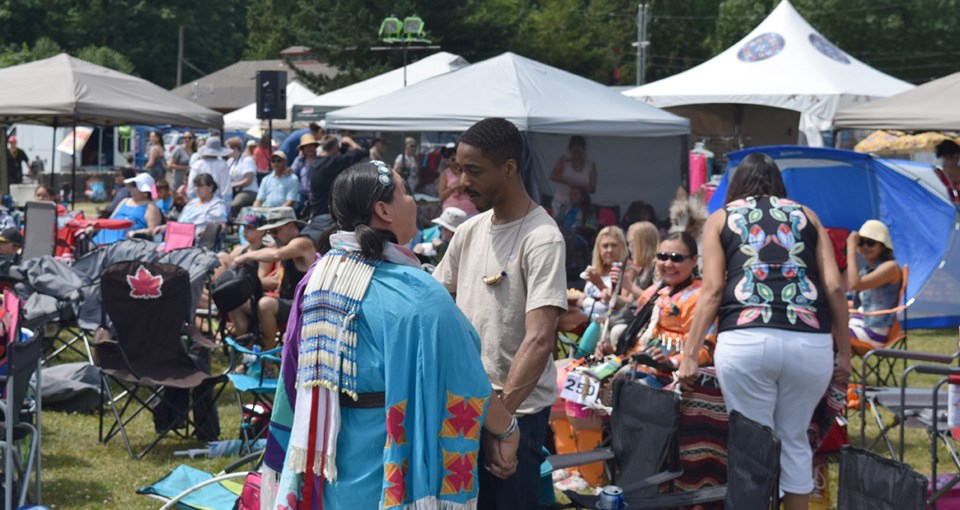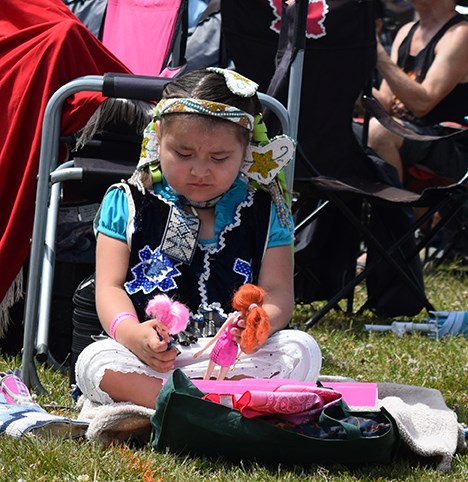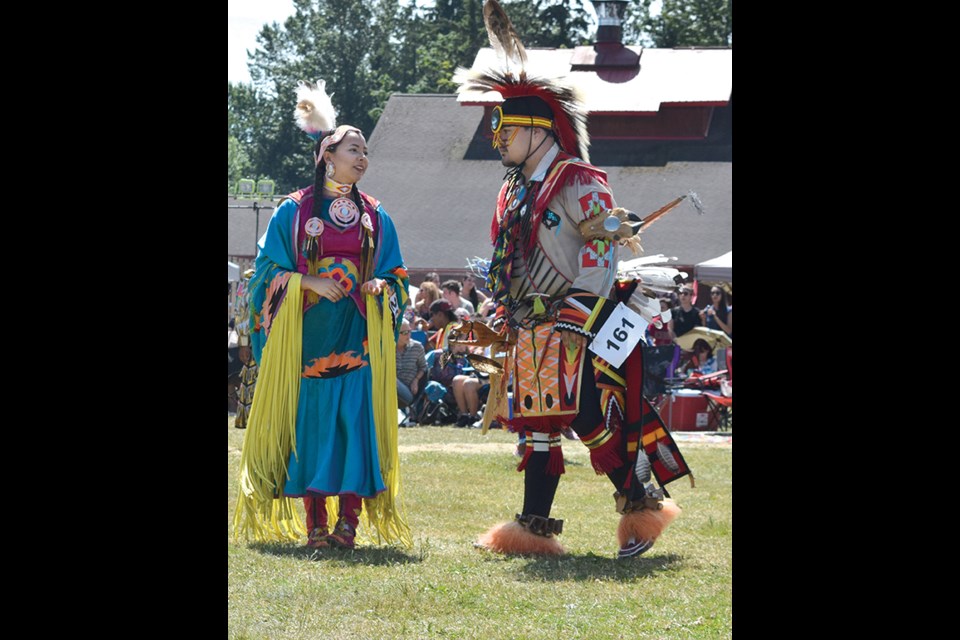As a mother braids her young daughter’s hair, the little girl closes her eyes and lifts her face to the morning sun.��
The daughter is dressed in her ӣ����ƵNation powwow dance regalia in anticipation of�� The Grand Entry– the official opening of Day 2 of the ӣ����ƵNation 30th Annual Youth Powwow on Saturday, at Capilano Reserve Park.��
While every generation is represented at the event, the 30-something parents with kids is definitely predominant and this demographic is not an anomaly.��
About 56 per cent of ӣ����ƵNation’s members are 34 years old or under, according to its 2016 annual report, Supporting and Sustaining Our Community and Culture.
The ӣ����Ƶ caught up with 44 year-old, Chief Ian Campbell (Xalek/Sekyu Siyam), who is one of 16 hereditary chiefs of the ӣ����ƵNation. The conversation covered everything from plans for young people to how the nation will ensure its members benefit from the band’s increasing revenues.��
What follows is an edited version of that exchange. ��
Q: How do you plan for the future of such a large, ӣ����ƵNation youth demographic?��
A: That has been the trend for some time now. The majority of First Nations across Canada are a similar demographic. For the Squamish, we always ask ourselves, “Why are we doing this if there is not a youth component?” Certainly our youth programing is fundamental, with cultural camps and hunting camps, tribal journeys canoe journeys; a lot of these opportunities are for young people to really celebrate the culture and learn it.�� Also, in the schools it is important for us to go and meet with youth groups and inform them of some of the major files we are working on and inspire them that they have a very important role to play in that – that their future is full of opportunity, should they wish to pursue any of those areas.��
Whether it be Whistler Blackcomb or any of our land developments and the acquisition of forestry licenses, we’re always wanting to create the space to mobilize our citizens, who for the most part are young people.��

��
Q: Forty-eight per cent of ӣ����ƵNation members live off-reserve and Nation members, like people in the rest of the Lower Mainland and Sea to Sky Corridor, are impacted by the current housing affordability issue. The Nation recently undertook a housing review, correct?��
A: This has been an ongoing issue for many years, where we are not able to keep up with single detached housing for every member and we are running out of reserve land, developable lands and we are needing to move toward density, whether it is townhouses or mid-rise apartments, that is an opportunity to solve a bit of the crisis for affordable housing. We are coming up with plans and introducing that to community because we felt it is not fair to just suddenly, arbitrarily switch gears from single detached houses and move directly into density. That wouldn’t really be fair to the next people who are in line for houses. So we want to get some buy-in from the community that this is the vision, the plan and the timing and the type of cost that would be associated with it. The next part is we need to generate the capital to invest in housing on reserve so the other economic projects we have are the vehicle that we have to reinvest money back into the community. ��
��
Q: Some ӣ����ƵNation members complain about the lack of general assemblies that the Nation holds,. How transparent and accountable is the Nation ?��
A: Chiefs and council has certainly committed to transparency and taken a number of steps to make sure it is accountable to its members. The general meetings, we started to change the format of those meetings because we felt that they were not as productive as they could be and they weren’t attracting the numbers that would be required to fully engage our members and have useful and productive sessions. One of the biggest gaps for the nation though is a communications department. In the absence of a communications department we don’t have the technicians that are constantly pumping out facts or figures and information to our members on any given project. We need to improve on communication. That is something that I feel is a priority that we consider the internal and external audiences and that is going to require some growth within our organization. I respect members vocalizing their opinions on whether or not we communicate. We could do better, absolutely.
��
Q: The Nation has an economic development-restructuring group. What is that about?��
A: It is really imperative, in my mind, for the ӣ����ƵNation to now move to the next iteration of growth in defining the roles and responsibilities of our council as our government and creating the business arms through master limited partnerships, separate boards of directors that are appointed by council with chief executive officer, chief operating officers and all of the subsidiary businesses located under that umbrella, that becomes the implementation arm on behalf of the Nation and so you minimize political interference and you create stability. Chief and council continue to be in the driver’s seat with the terms of reference, the mandates, the scope, the principles, the performance and then you allow that economic arm to then process. That is basically the direction we are heading in. So, for the last six months, the council has been engaged in developing that vision and structuring it on what are the human resources implications for current staff who work within any of our businesses; when and how do we transition.��
��
Q: The Nation hasn’t officially finished with its negotiations with the provincial government over Woodfibre LNG, so where are you with that, especially given the changes in Victoria of late.��
A: We are going to our council soon, mid-July, with our term sheet on the impact-benefit agreement for Woodfibre LNG. There’s a couple of outstanding pieces, one is where does BC Hydro fit into this accommodation package. We feel though that the skeleton of the agreement is in place, we want to update our council and then have a mandate to proceed toward concluding the entire process in the fall. Certainly the work that has been done with the province thus far was important because we identified lands, revenues and any of the benefits that would be shared by the province and the ӣ����ƵNation – it was important for us to solidify that prior to the election May 9, knowing that there could be some disruption and change.��
��
Q: And what about negotiations with FortisBC about the Eagle Mountain – Woodfibre Gas Pipeline Project?
A: Negotiations continue, but again we are feeling like with the term sheet, we have pushed on as many doors as we can to ensure that all of our conditions will be met over the life of the project and FortisBC conducted their analysis and came back with different types of approaches for our consideration.�� I feel that the Nation has now been able to get some greater certainty on ensuring that our conditions will be met as well. So, that would be part of the package that is being presented to council. ��
��
Q: What is the role of the Nation with the Burnco Aggregate Mine Project in Howe Sound?��
A: We’ve been participating in the provincial environmental assessment of Burnco. I know that there was concern over access for Nation members to continue to harvest elk in the Mcnab Valley and also the issue of what types of impact to the fisheries this may have when we are seeing the revitalization of Howe Sound, are we able to mitigate those risks? Knowing that the project would be located on private land, somewhat limits the Nation’s ability to fully engage other than in the EA process. It has been an interesting relationship to build with Burnco over the last number of years.��
��
Q: The Nation had revenue of close to $76 million and expenditures of close to $66M in 2016, how do you ensure that is trickling down to your�� roughly 4,000 members?��
A: Basically we have transfer dollars from the federal government that are non discretionary, they are specific to health and education and things like that and then the own source revenue that the Nation generates, 100�� per cent of that goes into programs and services to cover off costs that aren’t covered by the federal government: so elders programs, recreation, language and a number of other programs that the nation funds ourselves for the benefit of our members.�� That is controlled by our finance department who monitors and tracks it and then chiefs and council is the authority that approves the annual budget and allows the work plans from department heads, ensuring they follow their mandate and that they are able to be on budget and on time with spending.





